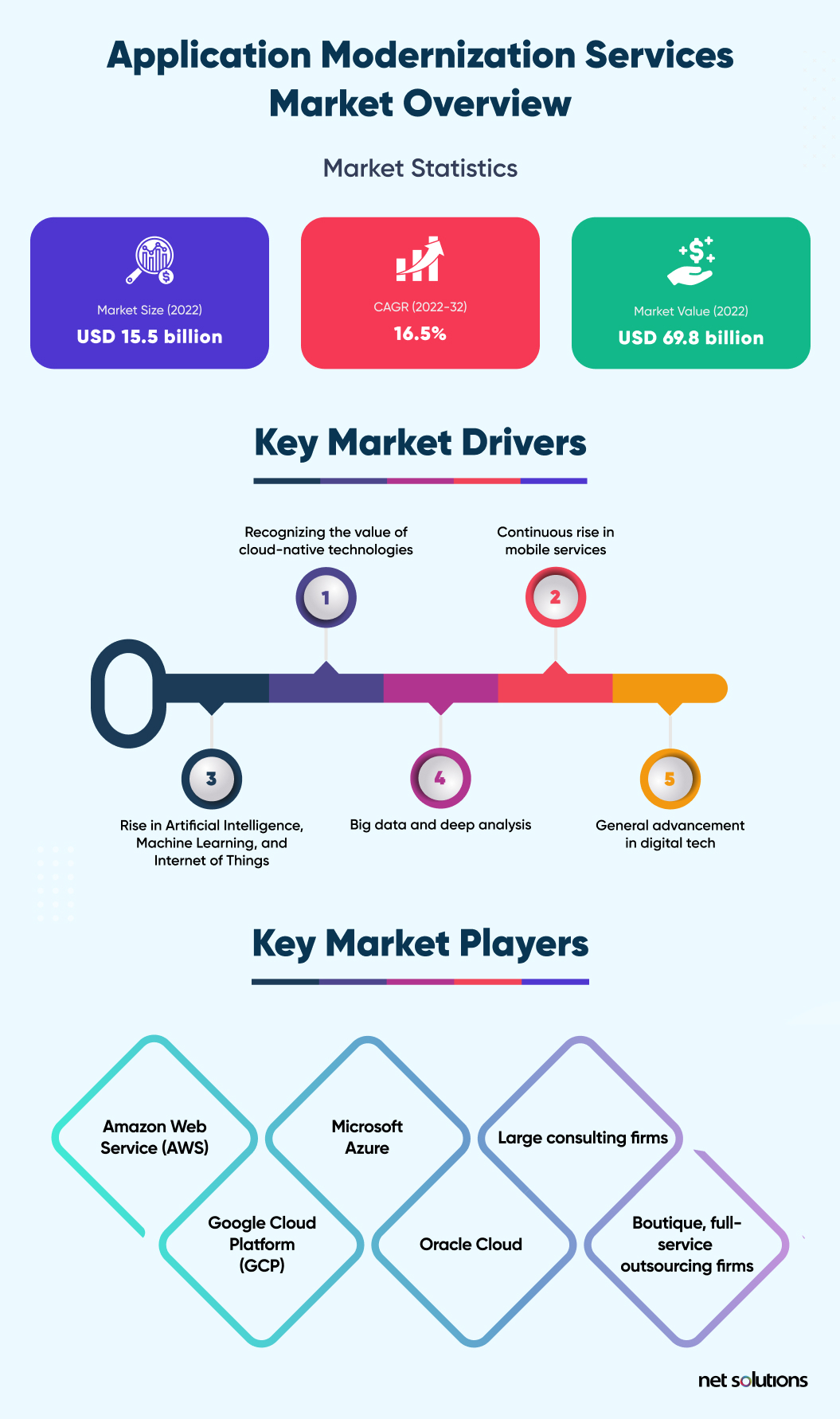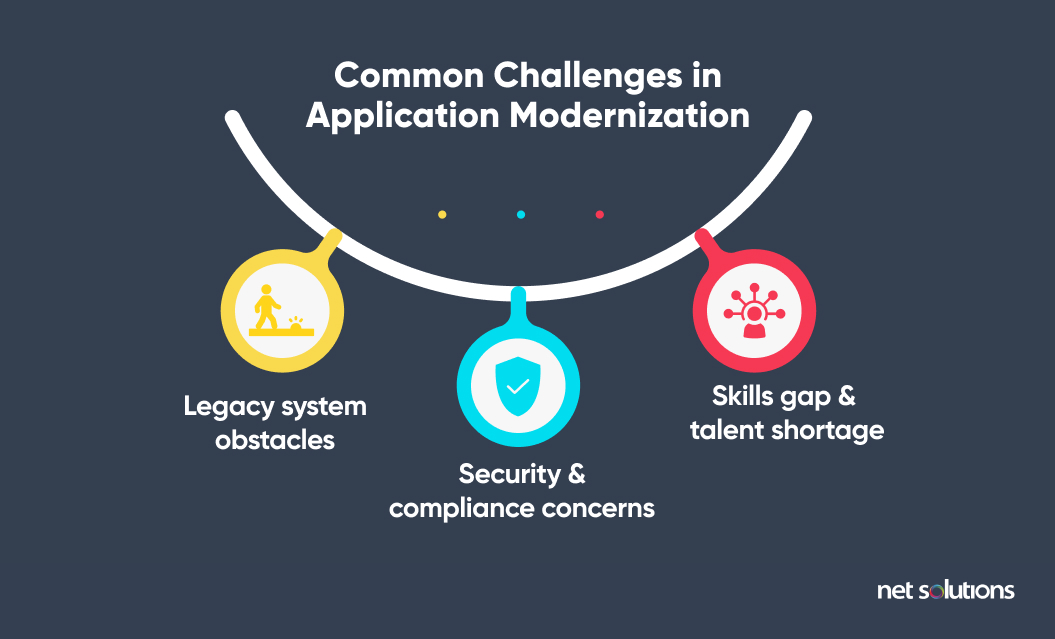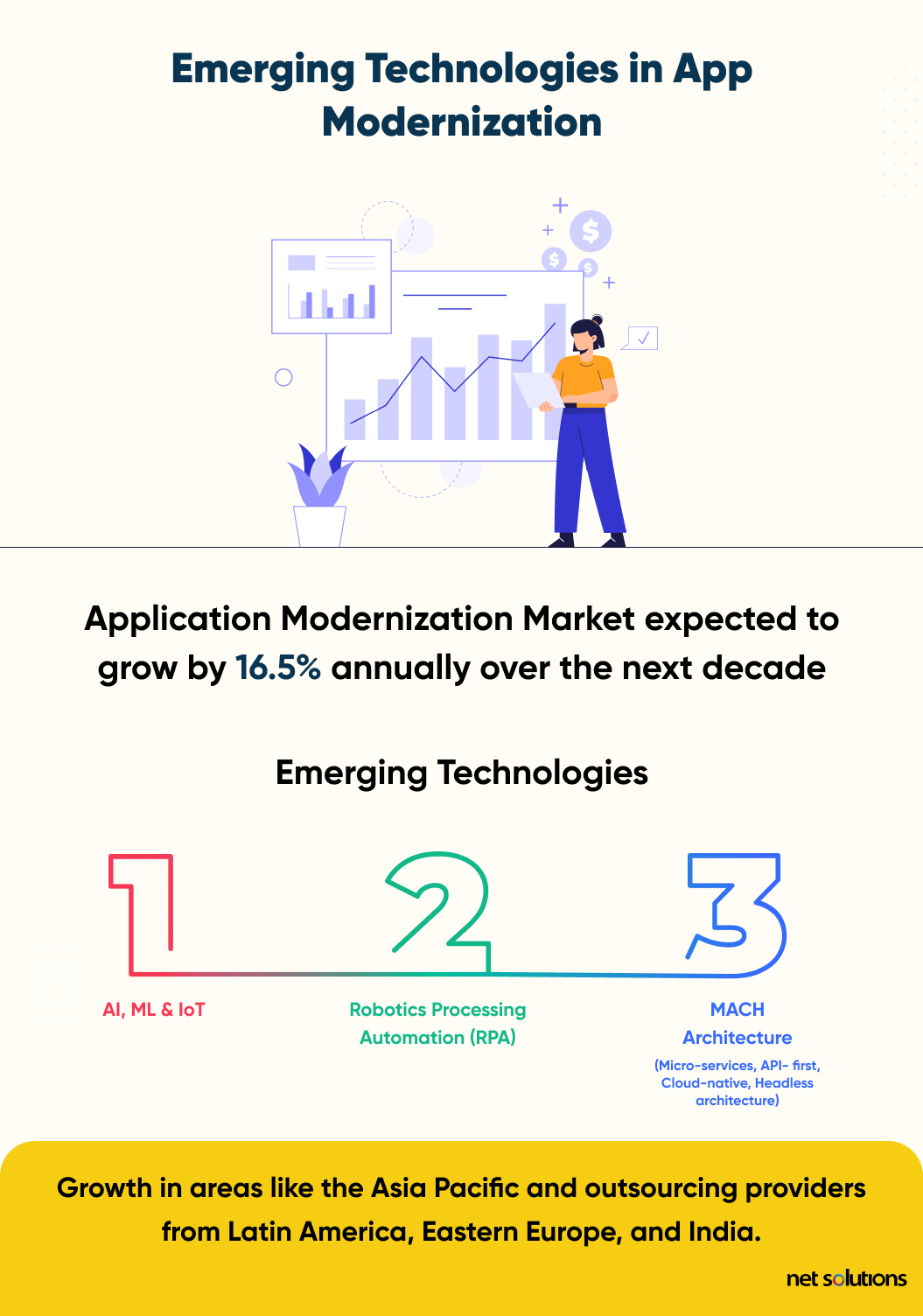The market for application modernization is growing around the world. Large enterprises are engaging in digital transformation to remain competitive and take advantage of all the cutting-edge capabilities that cloud computing has to offer.
Swapping legacy applications for modern, cloud-native apps isn’t about getting something shiny and new. It’s about adopting high-performing, secure software systems that can take advantage of new technology like Artificial Intelligence (AI), Machine Learning (ML), and the Internet of Things (IoT).
Companies with modern applications are optimizing supply chains, gathering actionable data, improving their customer experience, and more.
This blog will outline the factors that are influencing the current application modernization services market size, along with what drives it and what holds companies back from embracing the latest technology.
Application Modernization Market Overview
The current market for application modernization is vast, with a wide range of drivers and key players across the globe, from North America to India. In this section, we’ll explore the current market size for all services that impact the market, along with growth projections based on reputable market research reports.

We’ll also explore factors that are driving the market, key players in different types of services associated with app modernization, and other market dynamics.
- Market Size (2022)
- USD 15.5 billion
- CAGR (2022-32)
- 16.5%
- Market Value (2032)
- USD 69.8 billion
Key Market Drivers
- Recognizing the value of cloud-native technologies
- Continuous rise in mobile services
- General advancement in digital tech
- Rise in Artificial Intelligence, Machine Learning, and Internet of Things
- Big data and deep analysis
Key Market Players
- Amazon Web Service (AWS)
- Google Cloud Platform (GCP)
- Microsoft Azure
- Oracle Cloud
- Large consulting firms
- Boutique, full-service outsourcing firms
Market size and growth projections
A 2022 study identified the total value of the app modernization market at $15.5 billion USD, and it’s expected to grow at a rate of 16.5% CAGR to reach $69.8 billion by 2032.
Follow the links above to learn about the research methodology that produced these figures, along with growth opportunities, market trends, and factors that predict changes throughout the forecast period.
16.5% is an impressive growth rate for any industry, and there are a number of factors driving that figure. We’ll explore some of those drivers to understand what is contributing to the growth.
Of course, you may be wondering why we’re not seeing an even higher rate of growth, considering the powerful returns that come with app modernization. We’ll explore market growth inhibitors as well, to give you a well-rounded view of the marketplace.
Key drivers of market growth
What follows are five key market drivers that have influenced the massive market growth in app modernization in recent years, and why it is likely to continue into the next decade.
Recognizing the value of cloud-native technologies: Cloud-native applications can take advantage of all that cloud computing has to offer, including the flexibility that comes with containerization and headless architecture.
Continuous rise in mobile services: Modern apps offer greater compatibility across different platforms, including mobile devices. Today, more than half of all internet traffic comes from mobile devices (58.33%), and modern apps make it possible to serve mobile users better.
General advancement in digital tech: Digital technology is becoming increasingly more complicated and advanced, and modern apps are often necessary to support the latest technology. More leaders are becoming cognizant of the fact that legacy applications just aren’t sufficient to support more complicated systems.
Rise in Artificial Intelligence, Machine Learning, and Internet of Things: AI, ML, and IoT are playing key roles in gathering and processing data, as well as managing supply chains and keeping warehouses fully stocked. The flexibility of modern apps allows companies to integrate these technologies in a range of industries, from telecom to retail and consumer goods.
Big data and deep analysis: Modern, cloud-native apps break down data siloes and allow companies to collect and process data, along with tapping into big data stores. Knowledge is power, and data analysis provides a massive competitive advantage when it comes to market segmentation and business intelligence.
Key inhibitors of market growth
What factors are currently inhibiting market growth for app modernization?
The upfront cost of adoption: Even though the potential ROI is high, the initial price tag for modernization is high as well.
Complexity of transformation: Digital transformation and app modernization are complex endeavors, and most companies don’t have in-house IT staff who have the necessary skill set to take on the task. After all, app modernization is not an everyday job for most people, and the current skills gap contributes to the high failure rate of app modernization projects.
Difficulty finding the right partners: It’s often best to turn to a seasoned outsourcing partner for help with app modernization, but finding the right partners can be challenging. In a recent study, 18% of executives cited finding the right partner as a major hurdle.
Securing the support of executive management: 11% of IT leaders found it difficult to gain the support of executive management when attempting an app modernization program.
All these factors impact the growth rate of the global application modernization services market.
Key players in the market
Which companies are playing a central role in the app modernization market, taking a significant portion of the global market share from China to Canada?
Here are some company profiles and key players in the market, from cloud infrastructure providers to consulting firms.
Amazon Web Service (AWS): AWS is the largest player in the cloud infrastructure marketplace, with a whole host of support services that allow companies to get up and running quickly and thrive on the cloud.
Google Cloud Platform (GCP): Google has become a key player in the cloud infrastructure market as well, offering the cutting-edge features you would expect from the tech giant, including AI and ML integration.
Microsoft Azure: Microsoft is another popular cloud platform with its own advantages, including ease of use and interoperability between systems.
Oracle Cloud: Oracle Corporation’s cloud platform is known for high performance and availability, along with competitive pricing.
Large consulting firms: IBM Corporation, Accenture, and other large consulting firms have become significant players in helping companies modernize apps, engage in re-hosting to move legacy systems to public clouds and private clouds, perform application re-platforming, and more.
Boutique, full-service outsourcing firms: A whole host of boutique consulting firms are helping companies modernize their apps. All around the world, from Europe to Africa, these firms implement modern, cost-effective solutions. Here at Net Solutions, we’ve spearheaded many digital transformations for large enterprises. for large enterprises.
These market players are an integral part of the competitive landscape, enabling enterprises to expand the functionality of their software systems and better serve their end-users.
Common Challenges in Application Modernization
Application modernization comes with its share of challenges, with some studies estimating that as many as 74% of companies fail to complete their app modernization initiatives.
It isn’t that app modernization is an impossible task—with the right strategy and partners, success rates skyrocket. However, you must be aware of common pitfalls while building your strategy, that way you can help mitigate the risks.

Legacy system obstacles
Legacy systems typically come with a fair bit of baggage, beginning with the many dependencies created between different software applications.
Modern apps built with a microservices architecture are far more flexible, but app modernization is typically an incremental process. Fully modernizing your set of interconnected applications will require careful planning.
We recommend performing a full application portfolio assessment, exploring all dependencies and identifying the limitations of your current systems. This is the first step in an application modernization process, done long before you go into deployment mode.
Legacy systems can have siloed data and compatibility issues, presenting app modernization challenges when it comes to maintaining security and compliance requirements that are key to many industries. Taking a strategic approach to your application modernization strategy can help you address potential problems before they arise.
Security and compliance concerns
Any time you make a major change to your software systems or your underlying infrastructure, you introduce potential security risks. From exposing data during migration to new systems that haven’t yet been tested in the real world, security and compliance represent a potential challenge for those engaging in app modernization.
If your modernization efforts are performed by internal staff, make sure you have protocols in place to address cybersecurity and compliance requirements. If you’re working with an outsourcing partner, vet them thoroughly to ensure they follow established procedures and understand compliance requirements related to your industry.
Sectors like healthcare, finance, and telecommunications have specific compliance requirements regarding cyber security, in addition to more general requirements for handling customer data like GDPR.
A solid partner must understand and adapt to your needs, and they should have cyber security Subject Matter Experts (SMEs) on staff to consult with your team.
Skills gap and talent shortage
A massive 28% of executives surveyed by Deloitte in their annual report on the state of technology identified “lack of adequate skills” as a major challenge to their IT efforts.
The current software developer shortage is a problem in and of itself, but when you narrow the focus on app modernization, the problem is further magnified. Simply put, most IT professionals don’t have much experience with app modernization, as it’s not a task most developers perform regularly in their line of work.
A clear solution to the skills gap and talent shortage involves collaboration—partnership with an IT outsourcing firm that has a proven track record of leading successful app modernization endeavors for large enterprises. Look for case studies on any prospective vendor’s website, along with client testimonials verifying successful cloud application migrations and app modernization efforts.
Shaping the Future of App Modernization
As more companies realize the benefits of app modernization, the industry will continue to grow in new and exciting ways. This will give birth to new technologies and further develop existing ones, improving performance and ultimately enhancing the user experience.

Let’s explore where the application modernization services industry is headed and how you can benefit from what’s down the road.
Emerging technologies and their impact
One of the biggest app modernization trends to look out for is the development and further implementation of AI, ML, and IoT within modern applications. This technology is evolving exponentially, and it will play an increasingly more powerful role in app modernization efforts.
Robotics Processing Automation (RPA) is another powerful app modernization trend, which is used to perform tasks like gathering information from a webpage and completing keystrokes which, in the past, only a human being could perform. Application integration within these technologies is essential.
We’ll of course continue to see a focus on MACH architecture, which stands for:
- Microservices design
- API-first architecture
- Cloud-native applications
- Headless architecture
Each of these elements supports the scalability, automation, high performance, and improved user experience associated with modern applications.
Predictions for the application modernization market
As we mentioned above, the app modernization market is expected to grow by 16.5% annually over the next decade, and market research suggests we can expect plenty of new and exciting technological advancements.
Research predicts market growth in areas like the Asia Pacific region, along with growth in outsourcing providers from areas like Latin America, Eastern Europe, and India.
Learn More About App Modernization
Are you looking to learn more about application modernization and how you can implement it successfully at your organization?
Net Solutions is an IT outsourcing firm that has been in business for over twenty years, and we’ve worked with leaders like
Euro Car Parts
and
IMG
to modernize their applications and increase their market share.
Frequently Asked Questions (FAQs)
1. What is the size of the application modernization services market?
The latest market research suggests that the current market for app modernization services is worth
$15.5 billion, and it’s expected to grow to $69.8 billion by 2032. The rapid growth is evidence of the powerful competitive advantage that app modernization provides, from data collection to scalability.
2. What is the biggest driver of application modernization?
Flexibility and scalability are among the biggest drivers for app modernization. Legacy apps simply don’t offer anything close to the flexibility that modern, cloud-based applications offer. With microservices architecture, containerization, and headless architecture, modern applications provide the flexibility and high performance that deliver a competitive edge.
3. What does the future of application modernization services look like?
The future for application modernization services looks bright, as more and more companies realize the benefits of working with modern, cloud-based apps. The sector expects to see a
growth rate of 16.5% through 2032, with more companies enjoying the benefits of app modernization. Those benefits include improved performance, better data collection, AI integration, and more.
SHARE THIS POST
Table of Contents
Related Services
Related Resources
- A Framework-based Approach for App Assessment
- App Modernization Benefits To Boost Your ROI and Future-Proof Your Business
- 11 Top Application Modernization Best Practices in 2025
- Building a Winning Application Modernization Business Case
- Legacy Application Modernization Case Studies & Success Stories
- Solving the Toughest Application Modernization Challenges
- Cloud-Native Application Modernization: Benefits & Strategies
- 8 Core Application Modernization Drivers
- Enterprise Application Modernization: Complete Guide [2025]
- Lift and Shift: The Modernization Formula for Legacy Apps
- Navigating Application Migration and Modernization [Guide]
- Application Modernization and Optimization: A Complete Guide
- A Practical Approach to Application Rationalization: A CIO's Guide to Managing Complexity and Reducing Costs
- What is Replatforming? A Beginner's Guide to Upgrading Your Technology Stack
- 7 Steps to Build an Effective Application Modernization Roadmap
- A Step by Step Guide to Application Modernization Strategy
- Explore the Best Application Modernization Tools and Resources
- 13 App Modernization Trends That Can Support and Optimize Your App Modernization Strategy

